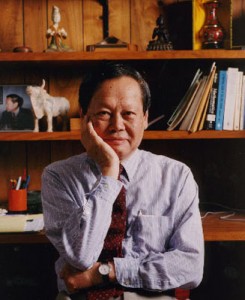Luca Mazzucato
An interview with C.N. Yang. A long-time member of Stony Brook University, Yang received the Nobel Prize in 1957 for his discovery of parity violation, together with T.D. Lee. In 1966 Yang founded the Institute for Theoretical Physics at Stony Brook, that now bears his name. While living in Beijing nowadays, Yang still pays frequent visits to the YITP to tell us about his most recent discoveries…
From his early years with Fermi to the current research on cold atoms, Yang shaped the way we look at modern physics: parity violation, integrability, gauge theory and much more…
There is a word that most of any other appears everywhere in physics. Equations, very diverse theories, bizarre physical phenomena, Nobel Prize awards. What they have in common is that they are all named after Yang, so much so that you might think about a massive case of homonym. In fact, the huge amount of discoveries all belong to the same person: Chen-Ning Yang, probably the scientist whose contributions shaped our current view of modern physics like no other. At the C.N.Yang Institute for Theoretical Physics at Stony Brook, Yang feels at home, and not only because it is named after him.
Most of Yang’s discoveries took place just around Stony Brook, where he arrived after obtaining his PhD in Chicago, under the supervision of Enrico Fermi. Yang has fond memories of Fermi: “Working with him had enormous influence on me,” Yang says, “I learned which problems he considered crucial and how to approach them.”
The eighty-nine year old physicist, now director of the Tsinghua University in Beijing, comes back to Stony Brook every year to update his old friends on his new findings, always with his typical enthusiasm….
Your current research focuses on condensed matter physics, going back to some papers you wrote decades ago. Would you tell us something about it?
Quantum mechanics gave rise to many difficult mathematical problems. In the 1960s Lieb and I found that in one dimension some of these problems can be exactly solved. This resulted in, among other things, what was later called the Yang-Baxter equation, which gave rise to important developments in mathematics and in mathematical physics.
How comes that physics that was cutting edge speculation back then is still the focus of advanced research now?
Such exact solutions could not be tested experimentally at the time. Miraculously, twenty years later, in the 1990s, new laser technology made such tests possible. Hence the new exciting field of Cold Atoms, and the revival of interests in those early works.
Your discovery that nature is not invariant under parity violation, for which you were awarded the Nobel Prize together with T.D. Lee, changed forever our understanding of nature. What does it mean and how did you discover it?
Parity violation is the technical term for violation of left-right symmetry. Before our paper, it was universally believed that right-left symmetry was 100% exactly observed. Prompted by some puzzling new experiments, we examined this belief in detail in 1956, and found (to our amazement) that in fact this symmetry had not been experimentally tested in a large class of physical processes. So we proposed several types of experiments to test it.
C.S. Wu led the first group which did one of these experiments and found (to everybody’s amazement) that this beloved symmetry had tiny but subtle defects. Rapidly more types of experiments were performed, confirming that this tiny but suble defect in the symmetry is a universal phenomenon. Why this tiny defect? That remains a major unsolved problem in fundamental physics.
Did you realize immediately the implications of parity violation while you were observing it at BNL for the first time?
When Lee and I wrote that paper at the Brookhaven National Lab in the summer of 1956, we did not anticipate that the experiments we proposed would lead to the discovery of any tiny violations of left-right symmetry. Nor did any other physicist, including Miss Wu herself.
After discovering so many aspects of nature, is there anything in physics that you still find exciting?
Yes, many things. But the most important, and also the most mysterious and awe-inspiring, is why the multitude of indescribably complicated natural phenomena observe fundamental, unifying, subtle and beautiful mathematical rules.
What’s your advice to a young student that would like to choose the research path in physics? And in science in general?
Find if your talents and interests are in physics. If yes, physics could provide a very rewarding career for you.


